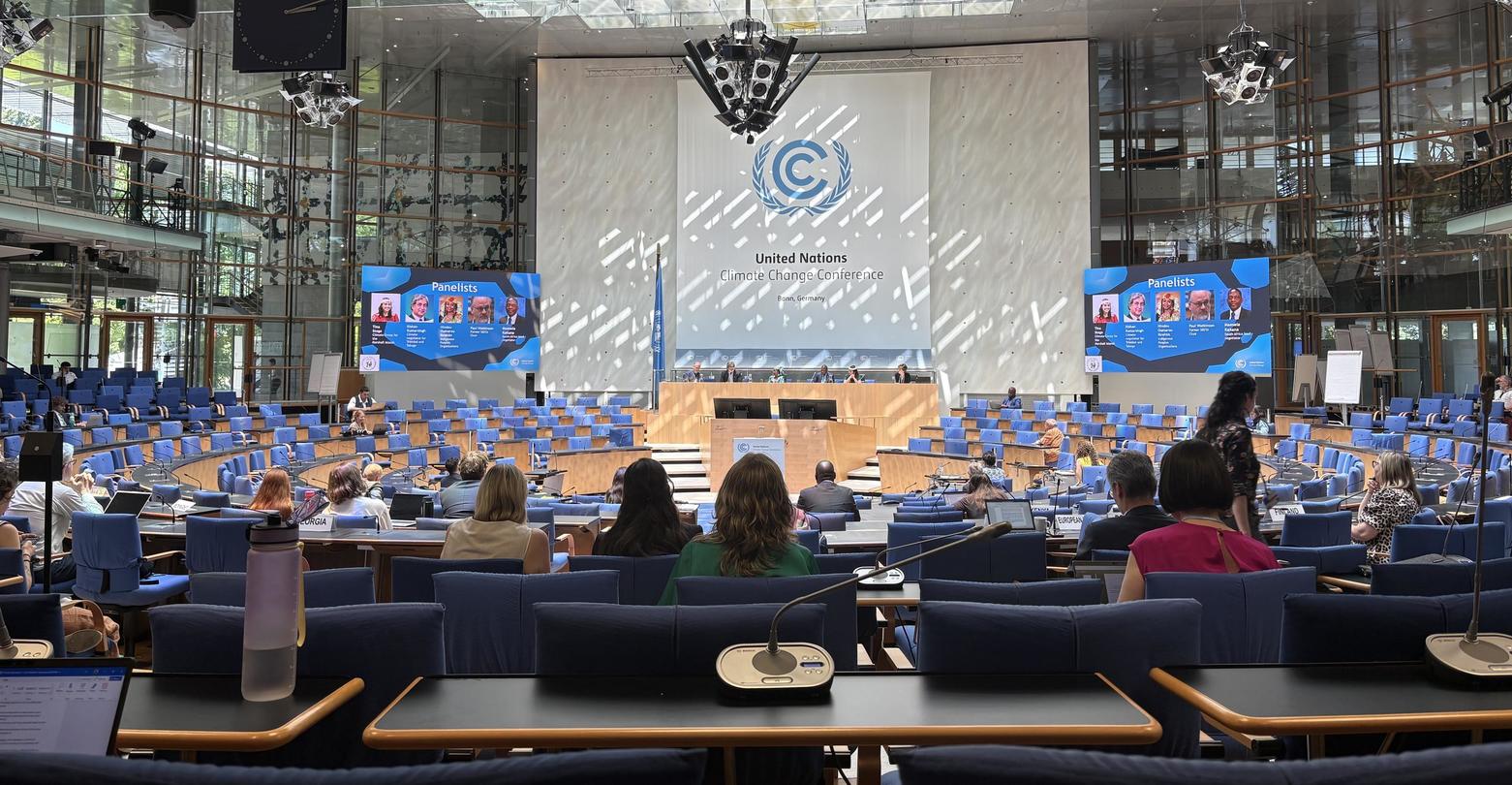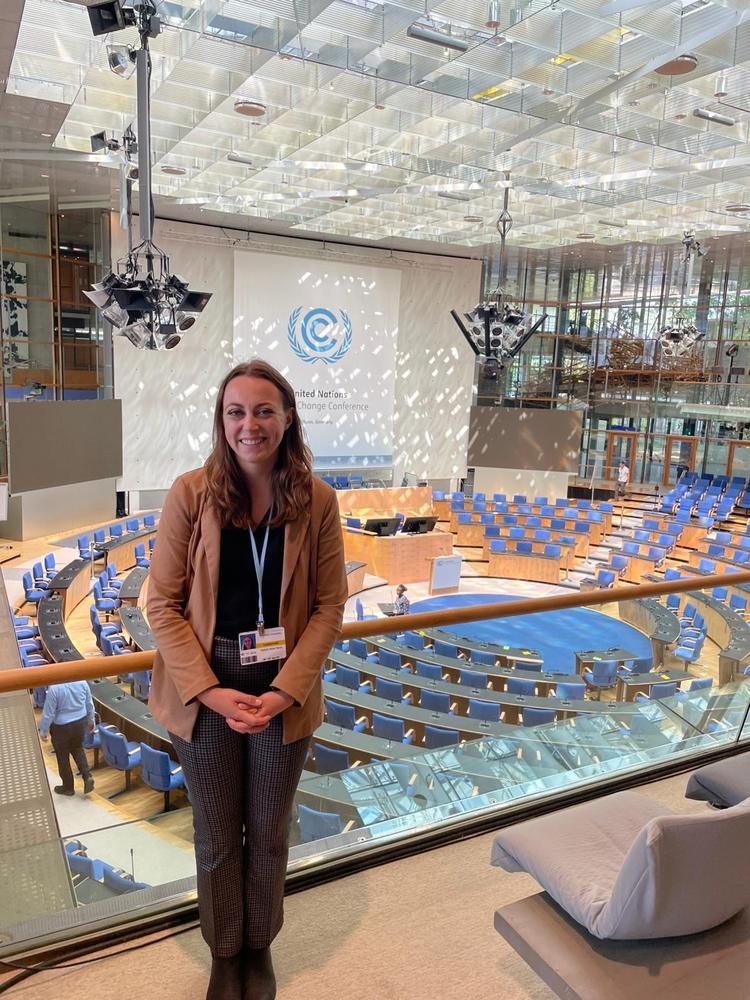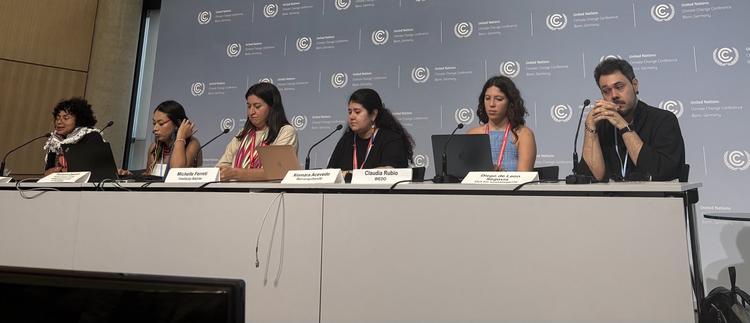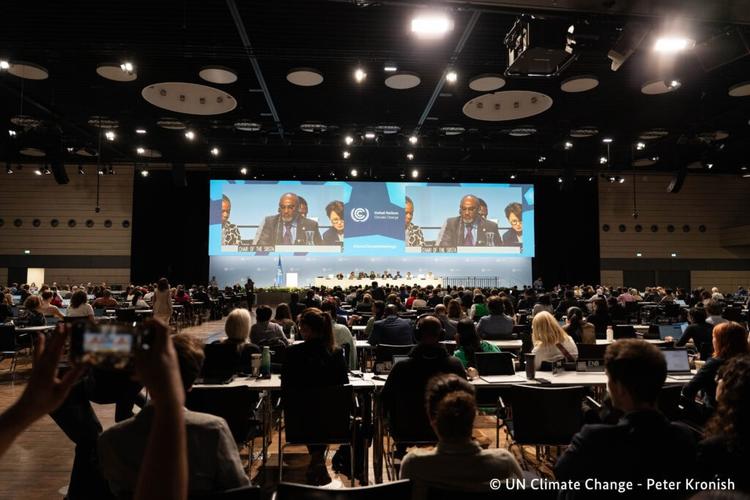C-PREE at the UN Climate Change Conference in Bonn: A Student Reflection

The United Nations Framework Convention on Climate Change (UNFCCC) Secretariat hosts two primary meetings each year: the Bonn Climate Change Conference typically held in June, and the Conference of Parties (COP) typically held in November. The Bonn Climate Conference centers around sessions of two permanent subsidiary bodies – the Subsidiary Body for Scientific and Technological Advice (SBSTA) and the Subsidiary Body for Implementation (SBI). These bodies assist the governing bodies of The Convention, the Kyoto Protocol, and the Paris Agreement in tracking progress, reviewing procedural and logistical elements of climate commitments, developing work plans, addressing methodological issues, and more. At Bonn, technical experts and government officials from across the world meet for these formal sessions, while also engaging numerous other stakeholders and observers through side events and networking opportunities.
Marking the 62nd session of the Subsidiary Bodies (SB 62), this year’s Bonn Climate Conference hosted discussions on various climate matters in preparation for COP30, which will take place in Belém, Brazil this November. This year, C-PREE sent three students to observe the Bonn discussions. Valerie Doze, Shelley Hoover, and Aaheli Tarafdar attended the conference and wrote reflections about the diverse array of climate topics covered at Bonn.

The 62nd session of the UNFCCC Subsidiary Body for Implementation (SBI) and Subsidiary Body for Scientific and Technological Advice (SBSTA) was held from 16th-26th June 2025 in Bonn, Germany, in preparation for COP30 in Belém, Brazil this November. Of particular interest to me was the scientific advice and assessment mechanisms, as well as the interactions of technical experts with policymakers.
At the Experiences in Scientific Assessment, Dr. Gabriela Iacobuta emphasized the assessment of environmental, social, and economic co-benefits of climate change policies, sharing the importance of countries redesigning and committing to their new Nationally Determined Contributions (NDCs). Mr. Elchin Allahverdiyev, the COP29 Presidency Representative, spoke of carbon crediting and carbon trading systems, as well as the ambitious NDCs that have already been submitted.
Towards Implementation: A Call to Deliver Action at COP30 featured multiple Climate High-Level Champions from the UNFCCC and COP30. A major component of the Action Agenda is the six proposed axes of action, one of foci on cross-cutting issues. The role of cities, regions, youth, and indigenous people, in addition to countries, was also emphasized.
At Research and systematic observation, the focus was on gaps and research needs in relation to science-based greenhouse gas reporting methodologies required for carbon accounting frameworks. It also touched on the importance of traditional, Indigenous, and local knowledge related to climate change, and climate justice.
Side events offered an interesting perspective. At one on the goals 10+ years out from the Paris Agreement, we heard from Ms. Tina Stege (Marshall Islands), Mr. Kishan Kumarsingh (Trinidad and Tobago), Ms. Hindou Oumarou Ibrahim (Indigenous Peoples Organizations), Mr. Paul Watkinson (Former SBSTA Chair), and Mr. Maesela Kekana (South Africa). During the post-Paris adoption, it is important to decide and plan why a country wants to host COP30, and especially to acknowledge the political rationale for hosting a COP. The call for finance is growing louder, as it is the enabler of climate action, especially in the Global South.
Overall, the SB62 experience was pivotal in illustrating the emphasis on language and drafting in the build up to a COP. It was interesting to see the interaction between technical experts and policymakers, as some sessions became too political for the technical topic at hand, and moderators had to reign in member states. Based on one-on-one discussions with those on the UNFCCC team, it is evident that health is missing from the climate agenda. With the first Health Day held at COP28, there is still a lack of crosstalk between UN agencies on this topic. Since addressing the climate crisis inherently requires an integrated approach, it is still startling that so little work has been done to integrate climate and health. It will be interesting to see the progress at COP30 this year, especially as Brazil has been integrating climate and health work for years.
Shelley Hoover, STEP Ph.D.
The 62nd session of the UNFCCC Subsidiary Bodies (SB62) runs June 16–27, 2025, in preparation

for COP 30 this November. I attended June 16–19, originally to follow the mandated meetings on extending the Lima Work Programme on Gender and developing a new Gender Action Plan. However, due to restricted access for observers, I shifted to tracking the UAE–Belém work programme on adaptation indicators, volunteering with the Women and Gender Constituency to take notes for advocacy on the inclusion of gender, class, and age in the indicators.
Background: The Global Goal on Adaptation (GGA), established in the 2015 Paris Agreement, lacked clear metrics due to adaptation’s context-specific nature. At COP 28 (Dubai), parties adopted the UAE Framework for Global Climate Resilience, including 11 targets and a cap of 100 indicators, to be developed via the UAE–Belém work programme. This process began in 2024 and aims to finalize indicators for adoption at COP 30 (Belém, Brazil). At SB62, the first formal negotiations reviewed a consolidated set of ~490 indicators.
Key Negotiation Tensions:
· Scale Reduction: Broad agreement on cutting to ≤100 indicators, but deep disagreements on selection criteria.
· Scope: Some wanted only direct GGA-linked indicators; others argued root causes of vulnerability must be included.
· Cross-cutting Issues: Some parties were hesitant to mandate gender, age, disability, and Indigenous disaggregation, citing reporting burdens. Brazil uniquely advocated for racial considerations.
· Loss and Damage: Disputes over whether loss and damage metrics reflect adaptation progress; compromise only if directly linked to adaptation.
· Existing vs. New Indicators: Many favored reusing SDG/Sendai indicators to ease reporting; others saw the need for new adaptation-specific measures, with funding for added burdens.
· Framework Structure: Agreement on “headline indicators” plus national sub-categories, but disagreement on definitions and whether headlines stand alone or are built from sub-indicators.
· Global vs. National: Debate over purely global indicators versus including national-level measures reflecting local variability.
Next Steps: A draft decision directs experts to restructure indicators before COP 30, with further workshops and negotiations to resolve these tensions. Final adoption is targeted for Belém in November 2025.
Aaheli Tarafdar, MPA
As someone whose interests lie at the intersection of geopolitics and public-private interactions, I was excited to attend the last few days of negotiations on the Global Goal on Adaptation, and Just Transition.

Global Goal on Adaptation (GGA): By the time I got to Bonn, parties had reached alignment on some of the more fundamental items on the agenda, like the plan to condense the list of indicators from nearly 500 to no more than 100. There has so far been limited progress on concrete and measurable indicators for adaptation, and the agreement that there would be a limited set of globally applicable headline indicators, with more context-specific sub-indicators, was an important point of alignment. The major source of tension (and the reason these negotiations went into overtime) was a discussion around "means of implementation" - meaning adaptation financing primarily flowing from developed to developing countries. Developed countries disagreed with the need to include these in the final document, preferring instead less strict language on "enablers". Developing countries repeatedly underscored the need for implementation support in no uncertain terms, and saw this as the developed countries shirking their responsibility. There was also disagreement around whether countries should be expected to disclose how much of their national budgets were going towards adaptation, which developing countries were concerned could be wielded against them in foreign aid negotiations. Ultimately, the final text was a compromise, to be further built out at COP30.
UAE Just Transition Work Program (JTWP): The JTWP is one of the 3 priorities of the COP30 presidency. Established at COP28, it focuses on the need for international cooperation on the topic (including the need for finance flows from developed to developing countries), and on enabling countries to develop context-specific national pathways. The JTWP negotiations similarly remained inconclusive and showed dynamics similar to the GGA. Once again, the topic of financing was a contentious one. However, there were some wins for civil society organisations and indigenous groups - namely, the inclusion of an option for a more formal mechanism to track the Just Transition agenda, especially after the JTWP ends at the end of 2026.
I also had the opportunity to attend a number of side events on a range of topics. Two of these stood out:
Limiting Harmful Influence in the UNFCCC: The UNFCCC has faced criticism for hosting COP in oil states, for giving the fossil fuel lobby as much latitude as it has done, and allowing corporations to influence the negotiation process. Many believe this has been the biggest obstacle to successful international climate negotiations. This event brought up the incongruity of the UNFCCC approach and those that have been applied in other UN framework conventions. For instance, under the UN Framework Convention on Tobacco Control, tobacco companies are explicitly not allowed to interfere with negotiations – vs in the UNFCCC, where fossil fuel companies spend up to $200m in lobbying efforts, influencing policy. As an example, part of this has gone towards campaigning for Article 6 - which is held up by corporates as an important part of the transition, but has been roundly criticised by many others in the field as being largely ineffectual and a way for oil majors to avoid phasing out fossil fuels. As someone with a background in the private sector (I even briefly worked as a chemical engineer for one of these oil majors!), this was eye-opening and provided an opportunity to reflect on how norms we consider to be widely accepted and indisputable are not in fact as set in stone as we might believe. Granted, tobacco is not as much of a core part of country economies as fossil fuels, and there aren't state-owned tobacco companies which make it difficult to create a real wall between corporations and states, but the principle remains.
Just Transition: This event highlighted the fact that there is no single definition of Just Transition, and that people's ideas range from a relatively reductionist status quo approach (green capitalism) to more transformative ideas around the way society works. While countries are starting to move away from the narrower, green capitalism definition, status quo approaches still dominate. The disagreements about the fundamental scope of Just Transition often slow down negotiations on the topic.
Overall, the events really showcased how vastly different priorities and approaches are between stakeholders. This was disheartening to see - these problems are not new and are in fact a major reason why climate negotiations have progressed more slowly than many environmentalists would like. Regardless, SB62 was a helpful reminder that incremental progress, while frustrating, is important given the incredibly complex nature of both the problem and the dynamics at play. It does not mean we should give up hope, it does not mean we should lose faith in the process, and it certainly does not mean we should stop trying.
